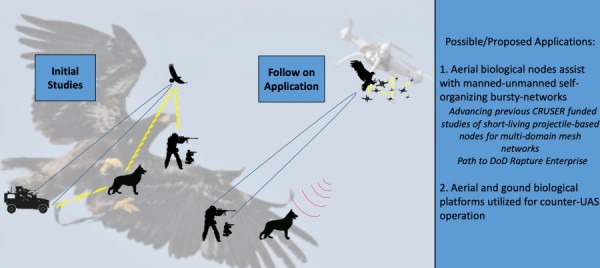

There are two words that could transform the nature of battlefield communications as we know it: Bird. Internet.
No, not the obscure throwaway ’30 Rock’ joke, but communications networks made up of Internet-enabled “biological nodes” like birds and dogs who, outfitted with wireless technology, function as transient network hubs for military personnel in contested battlefields.
“I named it ‘networks that don’t exist’—meaning that they don’t exist for noticeable period(s) of time or within well-defined areas of space,” explained Naval Postgraduate School research Alex Bordetsky in a Navy release. “So they move quickly, from one place to another, and then their setting changes.”
Such technology could provide U.S. forces with a significant advantage over adversaries by not just enhancing the reliability of mesh networks downrange, but increasing their range and discreteness in order to circumvent potential electronic counter-measures, per the Navy.

Bordetsky and his colleague Eugene Bourakov have been working for nearly two decades to develop and improve the tactical mesh networks that military personnel rely upon.
According to the Navy, their work at the NPS’ Center for Network Innovation and Experimentation (CENETIX) centers around “networks with short living nodes and links,” those that have the potential to enable “short bursts of communication, then [disappear] before an enemy can locate and infiltrate the network.”
While such “networks that don’t exist” can operate using unmanned vehicles as nodes, Bordetsky and Bourakov have spent the past two years experimenting with those so-called biological nodes based on both human and animals that can operate unaffected by electronic counter-measures like GPS jamming.

According to Bordetsky, animal nodes are “specifically suitable for contested environments in which cyber physical clutter is predominant,” like “when both friend and foe forces are communicating via multiple avenues in a small space or when one connection is underwater” as the Navy put it.
Such research has broad applications for a U.S. military currently reorienting itself towards ‘great power competition’ with adversaries like Russia and China, both of whom have shown a propensity to deploy electronic warfare and cyber operations against Western allies in recent years.
After years of relative superiority over non-state actors like terror organizations across the Middle East and North Africa, Bordetsky’s animal nodes might see potential use in helping U.S. forces in Europe maintain their communications networks while facing an increasingly contested battlespace.
Bourakov sums up the significance of the project nicely: “In modern warfare you have nothing if you do not have network.”
I’m just going to leave this here:
